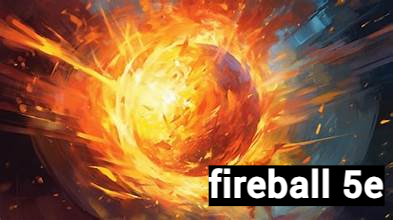In the realm of Dungeons & Dragons 5th Edition (5e), Fireball stands out as one of the most iconic and devastating spells in the game. This guide will delve into every facet of Fireball, from its mechanics and strategic uses to tips for maximizing its impact in your campaigns.
What Is Fireball?
Fireball is a 3rd-level spell available to wizards and sorcerers, known for its powerful area-of-effect damage. This spell allows you to unleash a ball of fire that explodes upon impact, dealing substantial damage to all creatures within its radius. It’s a staple in many spellcasters’ arsenals, particularly for those looking to make a dramatic impact in combat.
Spell Details
Level: 3rd
Casting Time: 1 action
Range: 150 feet
Components: V (Verbal), S (Somatic), M (Material – a tiny ball of bat guano and sulfur)
Duration: Instantaneous
Effect: When cast, Fireball creates a burst of fire at a point you choose within range. The explosion affects a 20-foot radius sphere centered on that point. Each creature within the sphere must make a Dexterity saving throw. On a failed save, a creature takes 8d6 fire damage. On a successful save, it takes half as much damage. The damage increases by 1d6 for each spell slot level above 3rd.
Strategy and Usage
Fireball is renowned for its high damage output and wide area of effect. Here are some key strategies to make the most of this spell:
Optimal Positioning
The key to maximizing Fireball’s effectiveness is in its placement. Since Fireball affects a large area, positioning is crucial. Aim to hit as many enemies as possible while avoiding allies or important NPCs. Use terrain to your advantage, such as casting it in narrow corridors where enemies are forced to cluster together.
Synergy with Other Spells
Fireball pairs well with various spells and abilities. For instance, using spells like Web or Hold Person can incapacitate enemies, making them more vulnerable to Fireball. Additionally, Cloud of Daggers or Spike Growth can be used in conjunction to deal damage over time in the same area.
Dealing with Fire Immunity
Some creatures are immune or resistant to fire damage. In these cases, consider using Fireball strategically to hit enemies who are vulnerable to it, while dealing with fire-immune foes using other spells or abilities. Always assess the creature types in combat to ensure you’re using Fireball to its maximum effectiveness.
Avoiding Friendly Fire
One of Fireball’s main drawbacks is its potential to harm allies. To minimize this risk, ensure that you’re casting it where allies are not in the immediate area of effect. Communication with your party is vital to avoid unintentional damage.
Advanced Tactics
For experienced players, Fireball offers even more strategic depth:
Heightened Spell
Consider using the Heightened Spell metamagic option to force enemies to roll at disadvantage on their saving throws. This can significantly increase the likelihood that your Fireball will deal maximum damage.
Maximizing Damage
When casting Fireball using a higher-level spell slot, remember that it increases in damage by 1d6 per spell level above the 3rd. This can be particularly devastating in large-scale battles or against particularly tough foes. It’s worth saving your higher-level spell slots for moments when you need to maximize damage output.
Combining with Area Control
Fireball can be combined with spells or abilities that control the battlefield. Spells like Wall of Fire can create a continuous area of fire that works well with Fireball’s initial burst, providing both immediate and ongoing damage.
Common Misconceptions
Despite its power, Fireball is often misunderstood or misused. Here are some common misconceptions:
- Fireball is Always the Best Choice: While Fireball is powerful, it’s not always the best choice. In scenarios where precise targeting is necessary or where enemies are spread out, other spells might be more effective.
- Fireball is Safe to Use Anytime: Fireball’s explosion can cause collateral damage. Use it wisely and be mindful of environmental factors or potential consequences of an uncontrolled blaze.
Fireball in Campaigns
Fireball has been a game-changer in countless campaigns. Its ability to turn the tide of battle or clear out groups of enemies makes it a valuable asset. Here’s how it can impact your game:
- High-Stakes Battles: In climactic battles, Fireball can be a decisive factor. It’s often used to weaken or eliminate large groups of enemies, giving your party a crucial advantage.
- Dungeon Crawls: In dungeon environments, Fireball’s area effect can help clear rooms of enemies. However, be cautious of the surroundings to avoid destroying valuable resources or accidentally setting off traps.
Conclusion
Fireball is more than just a spell; it’s a powerful tool that can dramatically influence the outcome of encounters in Dungeons & Dragons 5e. Mastering its use requires a combination of strategic placement, knowledge of its strengths and weaknesses, and an understanding of how it fits into the broader scope of your party’s tactics. By leveraging these aspects, you can ensure that Fireball remains a cornerstone of your spellcasting repertoire.

